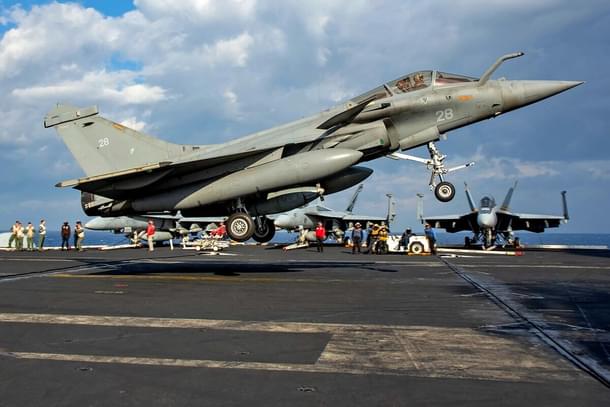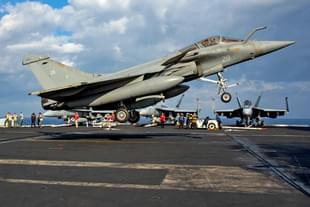Defence
Rafale M Emerges As Frontrunner In The Battle For Indian Nav's Lucrative Fighter Aircraft Deal: Report
Swarajya Staff
Feb 15, 2023, 07:48 PM | Updated 07:48 PM IST
Save & read from anywhere!
Bookmark stories for easy access on any device or the Swarajya app.


Rafale-M, the naval variant of the Rafale fighter in service with the Indian Air Force, has emerged as the frontrunner in the battle for the Indian Nav's lucrative fighter aircraft deal, Livefist has reported.
The Indian Navy evaluated French aircraft manufacturer Dassault Aviation's Rafale-M and US-based Boeing's F/A-18 Super Hornet earlier this year as it is looking to augment its dwindling fleet of fighters currently made up of the troubled Russian-origin MiG-29Ks.
The Navy has submitted a detailed report to the Defence Ministry after the trials. The report has identified Rafale-M as "more suitable in meeting the operational requirements" of the Indian Navy, the Times of India had reported earlier.
Earlier this year, the two fighters participated in trials at the shore-based test facility at INS Hansa in Goa to showcase their capabilities to take off from a ski-jump platform of the kind that Indian aircraft carriers have.
Rafale-Ms and Super Hornets have been in service with the French Navy and the US Navy, respectively, for years. The two navies operate these from their nuclear-powered aircraft carriers.
Unlike India's two carriers, which use ski-jump (short take-off but arrested recovery or STOBAR) to help aircraft take off from their decks, the US and French carriers use catapult-assisted take-off (catapult assisted take-off but arrested recovery or CATOBAR) to operate aircraft.
In the STOBAR system, aircraft are launched from a carrier using their own power with a ski-jump ramp on the bow of the carrier assisting take off. However, in the CATOBAR system, mechanical assistance is provided to the aircraft for take-off using a catapult, which is built into the carrier's flight deck. In both these systems, arrestor wires, which rapidly but smoothly decelerate an aircraft as it lands on deck, are used for recovery.
With the induction of the first indigenous aircraft carrier Vikrant on 15 August this year, the Indian Navy will have two aircraft carriers but not enough fighters to keep both warships operational.
In 2017, the Navy had projected a requirement of 57 new fighters. But it has since downsized the requirement to 26 fighters as an indigenous fighter for aircraft carriers — the Twin-Engine Deck-Based Fighter — is being developed by the Aeronautical Development Agency.
Dassault's Rafale-M has an edge over Boeing's F/A-18 as the Indian Air Force has already inducted two squadrons of the fighter, has set up maintenance facilities in the country and may contract for more Rafale.
India's rapidly expanding defense partnership with France, which also has interests in the Indian Ocean, will also be considered when New Delhi decides on the procurement of fighters.




